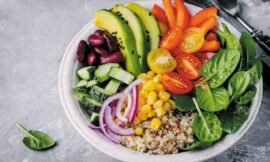The Zone Diet is a high-fat, low-carbohydrate diet based on a very specific macronutrient distribution and recommendations for eating low-glycemic foods.
In particular, the macronutrient distribution is to consume 30% dietary protein, 40% dietary carbohydrates and 30% dietary fat.
It is usually prescribed in “blocks” and eaten approximately 5 times a day.
Some of the key principles of the diet include consuming mostly low insulin release foods, optimizing satiety, and timing nutrient intake: 5 meals a day with no more than 5 hours between meals.
History of the zone diet:
The Zone Diet was developed by Dr. Barry Sears, a biochemist by training.
If you trace the history, the Zone Diet really began in the 1970s when Dr. Sears was completing his postdoctoral fellowship and his father died of a heart attack.
This life-changing event spurred Dr. Sears to research the causes of heart disease, and he began to develop the theory that dietary fats and how they regulate the body’s chemistry and hormones are key players in the development of obesity and disease.
An overview of the components and basic principles of the zone diet:
The Zone Diet is based on the idea that insulin and other hormones cause inflammation, and inflammation is the key to obesity and heart disease. The structure of the entire diet is designed to minimize these two things by optimizing hormones.
The Zone Diet involves consuming proteins and carbohydrates in a 0.75 or 3:4 ratio to reduce the insulin to glucagon ratio 1. The idea is that maintaining this ratio optimizes the production and regulation of eicosanoid metabolism and reduces the risk of disease, promotes weight loss and prolongs life.
To apply the diet, it is necessary to calculate the number of blocks to be consumed during the day. Each person is allocated a total number of blocks during the day. The number of blocks that each person is allowed is based primarily on biological sex, overall size and athletic status.
The total number of blocks often varies from 10 daily blocks for a small woman to 25 for an athletic man with good muscles. Meals are then broken down into 5 meals per day with blocks allocated to each meal.
The blocks are broken down by each macronutrient: 1 protein block – 7 grams of protein, 1 carbohydrate block – 9 grams of carbohydrates, 1 fat block – 1.5 grams of fats. Each meal should include an equal amount of each block. For example, a meal of 2 blocks would contain 2 protein blocks, 2 carbohydrate blocks and 2 fat blocks.
The following figure provides a graphical overview of a typical dietary distribution by zone.
Time/frequency of meals:
The zone diet involves a strict number of meals and a fairly rigid time structure.
The mantra of the zone diet is “5 meals a day with an interval of no more than 5 hours”.
Prohibitions/restrictions:
The zone diet has a certain list of foods that are recommended to be followed as closely as possible by those who practice the zone diet. Here is a list of foods that are encouraged by the zone diet.
Proteins: Beef, chicken, turkey, perch, halibut, lobster, shrimp, egg whites
Fats: Almonds, avocados, macadamia nuts, olive oil, peanuts, tahini, cashews, pistachios, sesame oil
Carbohydrates: Asparagus, black beans, broccoli, cabbage, cauliflower, chickpeas, kale, lentils, zucchini, zucchini, apples, berries, grapes, oranges, peaches. Slowly digesting grains such as barley and oatmeal are also allowed.
Does it include phases:
As a rule, the zone diet does not include prescribed phases either in its original formulation or in the latest update.
Who is it best suited for:
The Zone Diet is best suited for people who are interested in developing a diet that focuses on both the quantity and quality of their diet and enjoy a structured, planned diet.
The blocks determine the amount of food a person consumes, and the timing and distribution of the blocks gives structure to the day’s meals; this is often a preference for many. The food list focuses on the quality of the diet.
How easy is it to follow:
The zone diet often has a steep learning curve because people adopting the zone diet must learn about macronutrients, blocks, and the food list. Calculating the blocks often requires weighing and measuring food, which can also be a steep learning curve.
However, the zone diet can be easily maintained once the basic skills and patterns are established. The restrictive nature of the food list is probably the biggest barrier to long-term adherence to the diet.
Basic beliefs underlying the diet:
The basic belief underlying the zone diet is that a certain ratio of macronutrient intake and certain foods can optimize insulin and other hormone levels to maximize health, longevity and weight loss.
Read also:
Scientific research and data interpretation:
When discussing the benefits of implementing a zone diet into your lifestyle, several studies come to mind.
Some of them demonstrate that several intervention studies have had a positive effect on fat loss when adhering to the diet.
Others indicate that the zone diet can have a positive effect on several health parameters.
Fat loss:
The zone diet has been widely studied in the medical literature in terms of weight loss. Dozens of studies have shown that the zone diet can and does induce both weight loss and fat loss2-5.
Compared to other popular weight loss and fat loss diets, the zone diet has very similar fat loss potential, making it a very viable fat loss option for many people.
Health:
Although the zone diet is often used as a fat loss tool, it was originally created to improve health markers. When followed as prescribed and usually in the context of a hypocaloric diet aimed at weight loss, the zone diet can improve several markers of health parameters.
For example, in one study, the zone diet was shown to improve body weight, glycemic control, waist circumference, and inflammatory markers in individuals with type 2 diabetes 6.
Conclusion:
The Zone Diet is a dietary nutritional system that uses a 30/40/30 ratio of protein, carbohydrate and fat intake in order to optimize hormonal signaling.
The diet focuses on vegetables, some fruits, and other non-starchy carbohydrates and tends to use less carbohydrates and more fat.
One of the main philosophies is to consume low insulin release foods, optimize satiety, and time nutrient intake by eating 5 meals a day with no more than 5 hours between meals.








